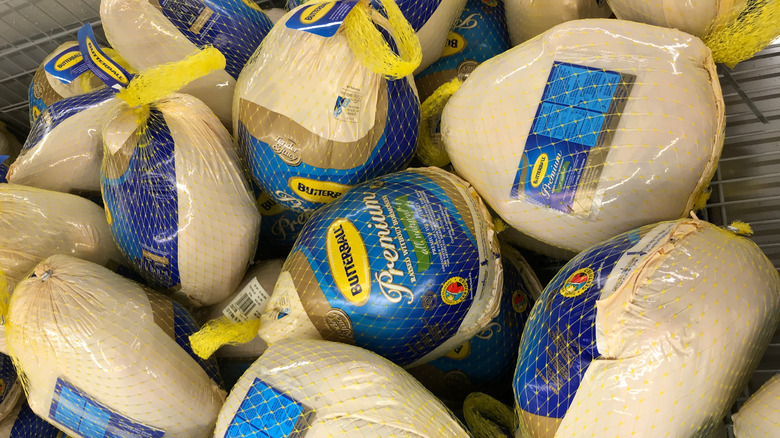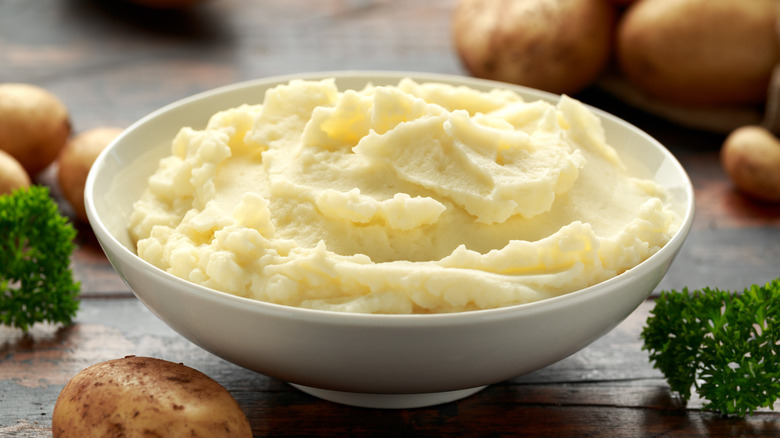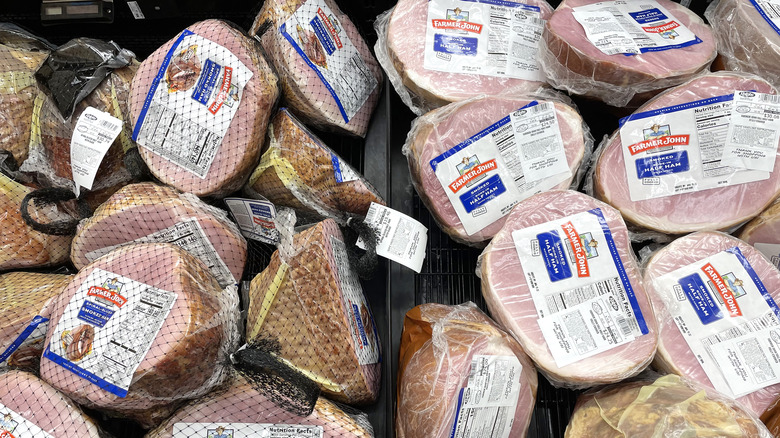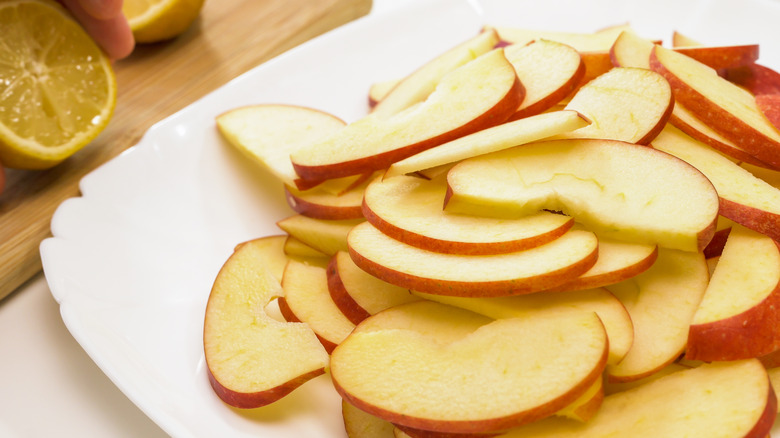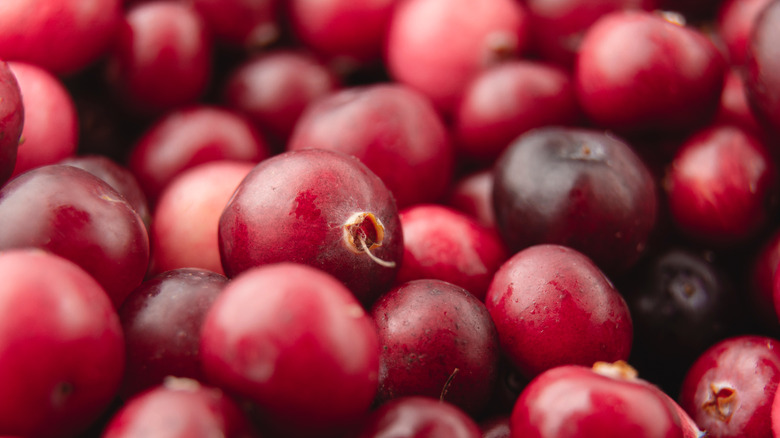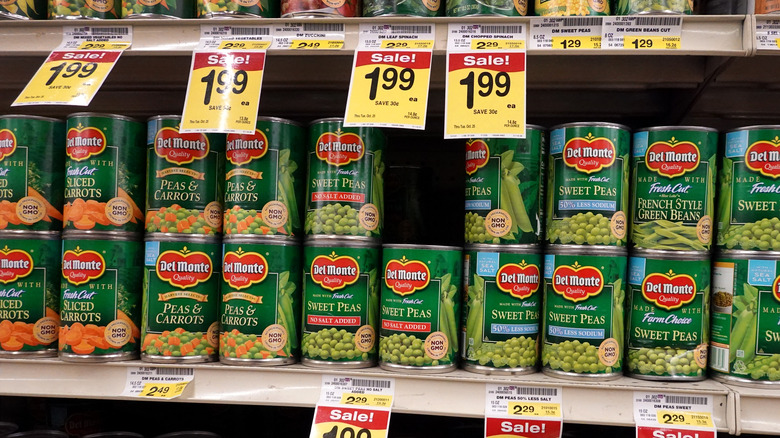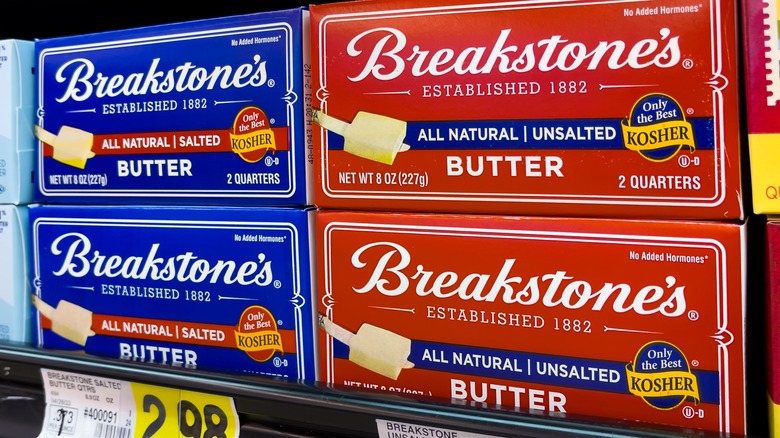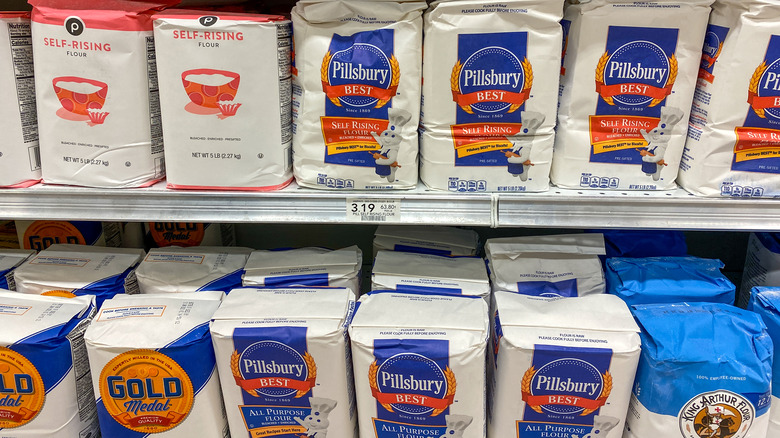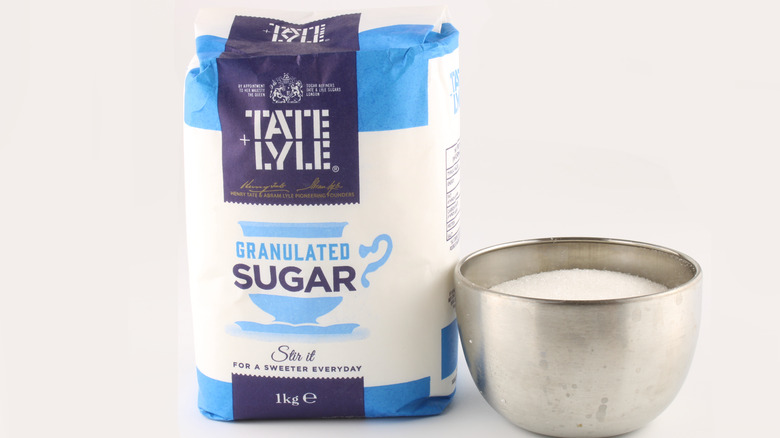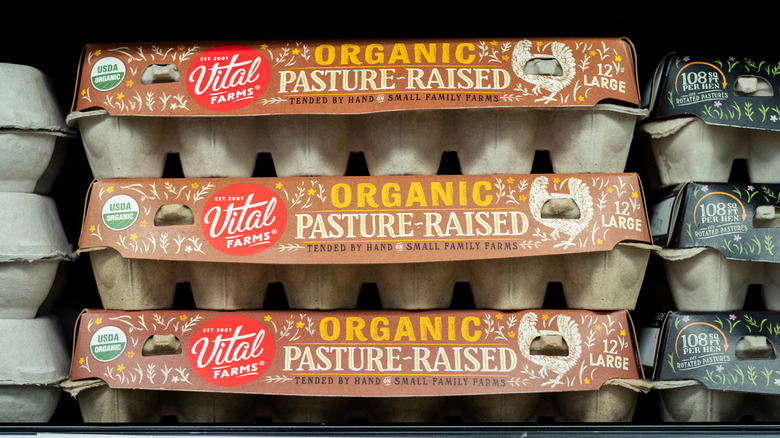How Much More Your Thanksgiving Meal Might Cost In 2022
If you've frequented your local grocery store for the past few months, you've likely seen incremental price increases on your favorite foods, including fresh, frozen, packaged, and prepared options. And not even the holidays are immune to these wallet woes. According to information from the Farm Bureau, prices for Thanksgiving meals between 2020 and 2021 surged around 14%, with the average meal for 10 people costing a little more than $53. Market analysis by Wells Fargo has predicted that we can expect to see even higher costs for this year's Thanksgiving dinner items.
The increase in prices for Thanksgiving dinner has caused many folks to consider heading to restaurants for Thanksgiving dinner instead, with prices around 6% higher than 2021 levels (via Wells Fargo). But if you are dead set on making a thrifty Thanksgiving dinner for your family and friends, here's what you can expect Thanksgiving staples to cost you this year.
Turkey
One of the biggest price jumps you can expect this Thanksgiving is on the bird itself, which may be more expensive than ever. According to an article published by The Wall Street Journal, the poultry industry was hit hard this year with a highly pathogenic avian flu that has culled many birds destined for the oven on Thanksgiving. As a response to the seasonal uptick expected in the avian flu, turkey producers have sent many birds to slaughter earlier than usual to ensure there will be enough turkeys for this holiday season. As a result, you will likely struggle to find birds bigger than 25 pounds widely available in grocery stores.
Another issue with the bird supply chain is the sheer cost of the turkey. The Wall Street Journal estimates a 57% increase in the price of turkey compared to its five-year average. To get the cheapest bird, we recommend buying in advance as your freezer space allows.
Potatoes
The financial prognosis for your bowl of mashed potatoes isn't as poor as you'd expect. Business Insider notes that potato prices have only increased about 2% since 2021, making this tuber a key staple in a thrifty Thanksgiving meal. That being said, the United States Bureau of Labor Statistics (BLS) reveals the average price for potatoes in June 2022 was around $0.89 per pound, which is nearly 20% more than in 2020. The issue with mashed potatoes, though, isn't the increased price of potatoes — it's the price of everything else (like the butter and the milk) required to make a heaping bowl of mashed potatoes.
If you're still looking to cut down on the price of your Thanksgiving meal, you can make your own instant mashed potatoes with a trip through the snack food aisle at the grocery store. Yes, you can combine three ounces of potato chips per cup of water. Although this hack might seem relatively new-age in the world of Thanksgiving food, boxed instant mashed potatoes use the same potato flakes as chip manufacturers do. If you opt for the chip, you are just getting more salt and flavor than using the boxed mix.
Sweet potatoes
Regular potatoes may be cheaper than other Thanksgiving staples, but sweet potatoes might be the smartest buy of the holiday season. IndexBox notes that the temperature variation in states like Idaho and Washington has caused some decline in the productivity of white and yellow potatoes, but has not affected the Southeastern United States, the primary region where sweet potatoes are grown. Sweet potato imports have also not been altered by the conflict in Ukraine, which has driven up vital food supplies of other Thanksgiving staples. Information from the Agricultural Research Service indicates the most recent average price for sweet potatoes was around $1.05 per pound. As a result, we can safely say that sweet potatoes are a good option, in terms of inflation, to purchase if you're looking to fill your Thanksgiving table.
Besides being price-stable, sweet potatoes are versatile options for Thanksgiving and can be made into a sweet casserole or used as a substitute for yellow potatoes in mashed potatoes.
Ham
If turkey is too much for your wallet to handle, you might look for other options like a glazed ham. But pork producers are not immune to the changes in the supply chain either. According to reports by Fox 8, pork products have been on a two-year increase due to changes in the supply chain and labor shortages in pork processing plants. Following the COVID-19 pandemic, prices for pork products including ham, bacon, and pork chops have surged, with the greatest increases for boneless pork products.
Data released by the United States Department of Agriculture notes that the price of ham averaged $5.50 in September 2022, up from $3.83 in September 2021 (via Fox 8). If you're looking for low prices on meat this holiday season, buying from bulk retailers or shopping in advance are two options. You can also dedicate some extra time and purchase bone-in ham this holiday season. And when all else fails turn to Spam — right?
Apples
Apple pie rivals pumpkin pie for the best Thanksgiving dessert. But with the price of apples, you may second-guess opting to make your grandmother's favorite apple pie recipe for the holidays this year. Per information from the Bureau of Labor Statistics, the price of apples has increased by 6% between September 2021 and 2022. Between August and September 2022 alone, the price of apples has increased by close to 5%.
If you are looking to make apple pie on a budget, you have a few different options like substituting fresh apples for canned apple pie filling. And if you want to purchase a frozen pie, think again. The Bureau of Labor Statistics also reports that frozen and refrigerated pies, turnovers, and tarts have increased in price by 20.4% between September 2021 and 2022. So, maybe making your own apple pie isn't that bad of an idea after all — or just stick to a cheaper canned filling like pumpkin puree.
Cranberries
Yes, there are people out there that still make cranberry sauce by hand and don't use the canned stuff. And if you're one of those people, purchasing cranberries will likely cost you more this year than in the past. Wells Fargo notes that dryness on the East Coast has caused many cranberry bog operators to utilize more costly irrigation practices to keep their operations afloat. Cranberry farmers in the Northwest have experienced unusual weather patterns that altered the ripening process of the berries. Despite these changes to the growing season, cranberry farmers are expected to harvest more berries than the year prior by about 5% (via Capital Press). In the meantime, it's difficult to tell if the production of the berries will be enough to keep prices similar to years prior.
If you're wondering if you should still keep cranberries on your Thanksgiving table this year, we would say so. Fresh or flash-frozen cranberries are the most nutrient dense, per information from the Texas Medical Center. Canned cranberries may contain added sugar and preservatives that make them a less healthy (but more indulgent option) than other cranberry counterparts.
Canned fruits and vegetables
Canned fruits and vegetables have increased in price by around 19% between September 2021 and 2022 (via the Bureau of Labor Statistics). Within August, the price of these canned vegetables increased by close to 2%. Canned vegetables have a slightly larger difference between the two periods, but the factor is marginal. If you want to revamp your green bean casserole with frozen vegetables, the prognosis looks somewhat better. Frozen fruits and vegetables had a 16.6% increase in price between 2021 and 2022.
There are some benefits to purchasing canned fruits and vegetables this season. Canned and frozen fruits and vegetables are typically cheaper than fresh produce, regardless of inflation, and have similar nutrient profiles to fresh options (via the National Kidney Foundation of Hawaii). If prices are volatile going forward, you may also consider purchasing canned or frozen produce to have on hand. Both of these preservation methods can extend the shelf life of nutritious fruits and veggies.
Wine
Not even your glass of cabernet is immune to price fluctuations. According to the Wine Economist, the average bottle of domestic wine increased from $8.12 to $8.46 between May 2021 and May 2022, while the average import bottle surged from $8.35 to $8.69 in the same period.
The Wine Economist connects the increased cost per bottle to the rise in inputs for wine production, including higher costs for fertilizer, fuel, transportation, and glass. Labor shortages in harvesting and producing wine are also difficult to find. But compared to other beverages, including sports drinks (which have risen in price by close to 17% in a single year), wine is just following along with the trends of other commodities. Data from the Bureau of Labor Statistics indicates that other alcoholic beverages like beer and spirits consumed at home have reported a price decline in the past year by between 0.3 and 0.5%. However, the amount spent on alcohol outside the home has increased in price by less than 1%.
Butter and margarine
You can't make a pie or garnish your dinner rolls without the addition of butter or margarine. Both butter and margarine are price sensitive in the volatile grocery climate of Thanksgiving, and this year's supply chain issues will no doubt cause major issues for consumers. Data from the Bureau of Labor Statistics indicates margarine has increased in price by 44% between September 2021 and 2022. Butter has had a slightly lower (but still large) change in price by 26.6% within the same period. In one month, the price of margarine has soared by 4.2%, and we can expect trends to continue into the buying rush of the holiday season.
According to CNBC, the increased cost of cattle feed and diesel have fueled increased production prices for farmers. Labor shortages up and down the supply chain have also increased the cost to produce the Thanksgiving products like butter and margarine — which it's clear we cannot survive the holiday season without.
Flour
You can't make a pie or dinner rolls without flour. The BLS notes that flour and prepared mixes have increased in price by 24.2% within the past year. According to News Nation Now, there are several reasons for the increase in prices for flour, many of which relate back to the invasion of Ukraine in early 2022. Russia and Ukraine produce close to a third of the global supply of wheat and flour. With the conflict and subsequent closure of ports and export centers, the world has seen a decreased supply of flour on the market. By the nature of supply-and-demand economics, this drives the price of flour up significantly.
Since flour is a critical ingredient on the Thanksgiving table for pies, stuffing, and dinner rolls, you should expect to pay more for not only dry flour but also flour-based products. In October, The New York Times reported that food company Nestle increased its prices by 9.5% this quarter compared to the third quarter of last year. The increases are in response to rising wheat prices globally.
Sugar
Data collected by Forbes Magazine indicates that sugar prices have slowly been on the rise over the past few years. The Bureau of Labor Statistics indicates that sugar and sugar substitutes (like stevia) have increased in price by 17% since September 2021 and by about 1.5% between August and September 2022 alone.
The cause for the "sugar high" is connected to supply chain issues, like many other ingredients. But outside of the supply chain, the sugar industry has suffered low sugar beet yields both domestically and globally (via Forbes Magazine). Unusual weather events like frequent hailstorms and heavy rainfall, as well as increased labor costs, have led to smaller sugar beet harvests in major production regions. From an agricultural perspective, the sugar beet requires a lot of fertilizer, which can further drive up costs for farmers and producers and caused many sugar beet producers to plant less this year.
Eggs
You may not think about eggs being a critical component of your Thanksgiving meal until you consider how they'll help you avoid crumbly stuffing or make a custard pie for dessert. And if you plan to DIY Thanksgiving with a lot of eggs this year, you should expect to pay more than you ever have before. According to the Bureau of Labor Statistics, eggs have increased in price by 30.5% since September 2021. KX News notes that consumers were paying upwards of $3 for a dozen eggs for only the second time ever. According to Deseret News, egg prices have soared due to the highly pathogenic avian influenza that has also impacted turkey and poultry production globally. KX News also notes that the lower yield of eggs has also stemmed from supply chain issues that have impacted meat and poultry production as a whole.
Is there relief for egg-hungry consumers? KX News notes this is likely since the cost of eggs has decreased by about 3.5% since August. Chicken producers have increased the population of chicks (which will eventually become laying hens) by 13% more than the previous hatching season, so it is likely we can expect to see prices level out for eggs — just in time for next year's Thanksgiving.

